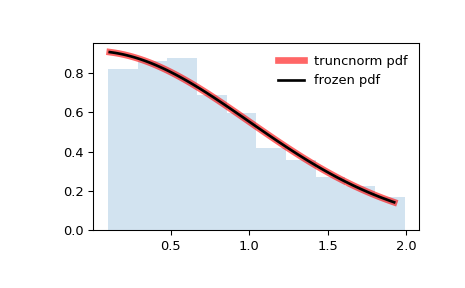scipy.stats.truncnorm#
- scipy.stats.truncnorm = <scipy.stats._continuous_distns.truncnorm_gen object>[source]#
A truncated normal continuous random variable.
As an instance of the
rv_continuousclass,truncnormobject inherits from it a collection of generic methods (see below for the full list), and completes them with details specific for this particular distribution.Notes
The standard form of this distribution is a standard normal truncated to the range
[a, b], whereaandbare user-provided shape parameters. The parameterlocshifts the mean of the underlying normal distribution, andscalecontrols the standard deviation of the underlying normal, butaandbare still defined with respect to the standard normal. Ifmyclip_aandmyclip_bare clip values defined with respect to a shifted and scaled normal, they can be converted the required form according to:a, b = (myclip_a - loc) / scale, (myclip_b - loc) / scale
Examples
>>> from scipy.stats import truncnorm >>> import matplotlib.pyplot as plt >>> fig, ax = plt.subplots(1, 1)
Calculate the first four moments:
>>> a, b = 0.1, 2 >>> mean, var, skew, kurt = truncnorm.stats(a, b, moments='mvsk')
Display the probability density function (
pdf):>>> x = np.linspace(truncnorm.ppf(0.01, a, b), ... truncnorm.ppf(0.99, a, b), 100) >>> ax.plot(x, truncnorm.pdf(x, a, b), ... 'r-', lw=5, alpha=0.6, label='truncnorm pdf')
Alternatively, the distribution object can be called (as a function) to fix the shape, location and scale parameters. This returns a “frozen” RV object holding the given parameters fixed.
Freeze the distribution and display the frozen
pdf:>>> rv = truncnorm(a, b) >>> ax.plot(x, rv.pdf(x), 'k-', lw=2, label='frozen pdf')
Check accuracy of
cdfandppf:>>> vals = truncnorm.ppf([0.001, 0.5, 0.999], a, b) >>> np.allclose([0.001, 0.5, 0.999], truncnorm.cdf(vals, a, b)) True
Generate random numbers:
>>> r = truncnorm.rvs(a, b, size=1000)
And compare the histogram:
>>> ax.hist(r, density=True, histtype='stepfilled', alpha=0.2) >>> ax.legend(loc='best', frameon=False) >>> plt.show()

Methods
rvs(a, b, loc=0, scale=1, size=1, random_state=None)
Random variates.
pdf(x, a, b, loc=0, scale=1)
Probability density function.
logpdf(x, a, b, loc=0, scale=1)
Log of the probability density function.
cdf(x, a, b, loc=0, scale=1)
Cumulative distribution function.
logcdf(x, a, b, loc=0, scale=1)
Log of the cumulative distribution function.
sf(x, a, b, loc=0, scale=1)
Survival function (also defined as
1 - cdf, but sf is sometimes more accurate).logsf(x, a, b, loc=0, scale=1)
Log of the survival function.
ppf(q, a, b, loc=0, scale=1)
Percent point function (inverse of
cdf— percentiles).isf(q, a, b, loc=0, scale=1)
Inverse survival function (inverse of
sf).moment(order, a, b, loc=0, scale=1)
Non-central moment of the specified order.
stats(a, b, loc=0, scale=1, moments=’mv’)
Mean(‘m’), variance(‘v’), skew(‘s’), and/or kurtosis(‘k’).
entropy(a, b, loc=0, scale=1)
(Differential) entropy of the RV.
fit(data)
Parameter estimates for generic data. See scipy.stats.rv_continuous.fit for detailed documentation of the keyword arguments.
expect(func, args=(a, b), loc=0, scale=1, lb=None, ub=None, conditional=False, **kwds)
Expected value of a function (of one argument) with respect to the distribution.
median(a, b, loc=0, scale=1)
Median of the distribution.
mean(a, b, loc=0, scale=1)
Mean of the distribution.
var(a, b, loc=0, scale=1)
Variance of the distribution.
std(a, b, loc=0, scale=1)
Standard deviation of the distribution.
interval(confidence, a, b, loc=0, scale=1)
Confidence interval with equal areas around the median.